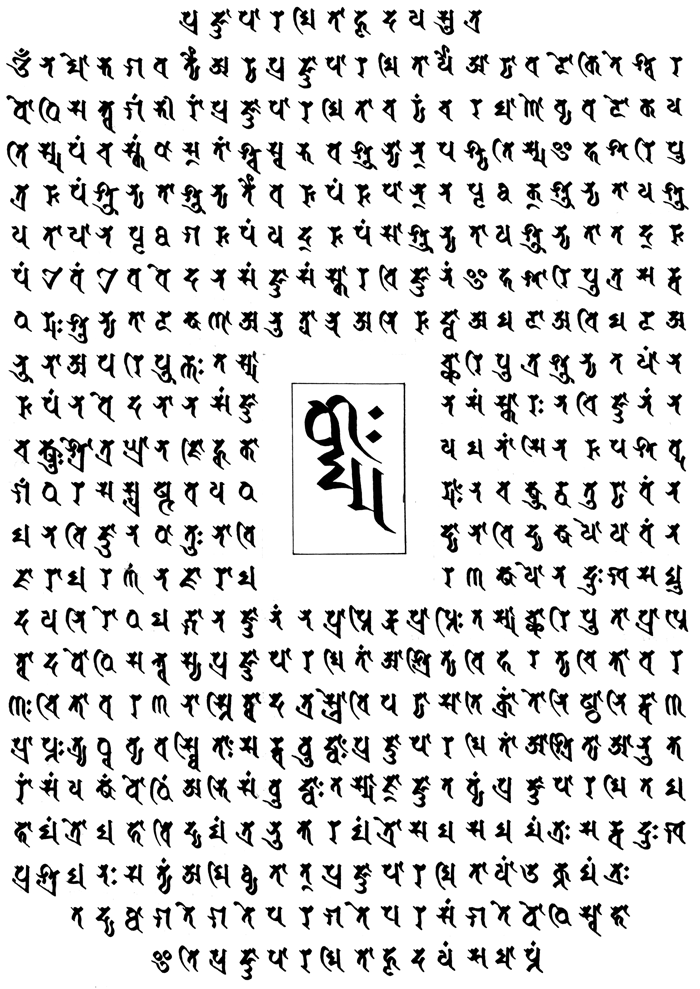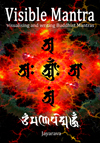The Heart Sutra is one of the best known, most chanted, of all sutras. It exists in a longer and a shorter form - the calligraphy here is of the shorter version. There are a number of standard commentaries on this sutra, which look at it from a variety of traditional view points. Versions are known in most of the important languages of Mahāyāna Buddhism.
Here is my Siddhaṃ calligraphy of the Sanskrit (following Edward Conze's Sanskrit edition as it appears in his book Buddhist Wisdom Books). See also my separate page for the Heart Sūtra mantra

prajñāpāramita-hṛdayam sūtra
oṃ namo bhagavatyai ārya prajñāpāramitāyai!
ārya-avalokiteśvaro bodhisattvo gambhīrāṃ prajñāpāramitā caryāṃ caramāṇo vyavalokayati sma:
panca-skandhās tāṃś ca svābhava śūnyān paśyati sma.
iha śāriputra: rūpaṃ śūnyatā śūnyataiva rūpaṃ; rūpān na pṛthak śūnyatā śunyatāyā na pṛthag rūpaṃ; yad rūpaṃ sā śūnyatā; ya śūnyatā tad rūpaṃ. evam eva vedanā saṃjñā saṃskāra vijñānaṃ.
iha śāriputra: sarva-dharmāḥ śūnyatā-lakṣaṇā, anutpannā aniruddhā, amalā avimalā, anūnā aparipūrṇāḥ.
tasmāc chāriputra śūnyatayāṃ na rūpaṃ na vedanā na saṃjñā na saṃskārāḥ na vijñānam. na cakṣuḥ-śrotra-ghrāna-jihvā-kāya-manāṃsi. na rūpa-śabda-gandha-rasa-spraṣṭavaya-dharmāh. Na cakṣūr-dhātur. yāvan na manovijñāna-dhātuḥ. na-avidyā na-avidyā-kṣayo. yāvan na jarā-maraṇam na jarā-maraṇa-kṣayo. na duhkha-samudaya-nirodha-margā. Na jñānam, na prāptir na-aprāptiḥ.
tasmāc chāriputra aprāptitvād bodhisattvasya prajñāpāramitām āśritya viharatyacittāvaraṇaḥ. cittāvaraṇa-nāstitvād atrastro viparyāsa-atikrānto niṣṭhā-nirvāṇa-prāptaḥ.
tryadhva-vyavasthitāḥ sarva-buddhāḥ prajñāpāramitām āśrityā-anuttarāṃ samyaksambodhim abhisambuddhāḥ.
tasmāj jñātavyam: prajñāpāramitā mahā-mantro mahā-vidyā mantro 'nuttara-mantro samasama-mantraḥ, sarva duḥkha praśamanaḥ, satyam amithyatāt. prajñāpāramitāyām ukto mantraḥ.
tadyathā: gate gate pāragate pārasaṃgate bodhi svāhā.
iti prajñāpāramitā-hṛdayam samāptam.
Notes
The bīja in the centre is dhiḥmma which is said by the Shingon tradition of Japan to be the essence of the Heart Sūtra. The Heart Sūtra itself is said to be the essence of the Perfection of Wisdom tradition. It combines dhīḥ the basic seed-syllable for the Perfection of Wisdom (prajñāpāramitā) with 'ma' the seed-syllable for Mañjuśrī in the Shingon tradition.
I've followed the Chinese pattern in lining the characters up in a grid in imitation of the way Chinese is written - though here they are read left to right, top to bottom. Siddhaṃ was, and is, written left to right often without word breaks - these can be worked out rom the spelling though it is not easy.
The first short line is the title: pra jñā pā ra mi ta hṛ da yaṃ sū tra
It is now generally believed by scholars that the Heart Sutra was composed in China. The part from the first "iha śāriputra" down to "Na jñānam, na prāptir na-aprāptiḥ" was extracted from the Chinese translation of the Sanskrit Pañcaviṃśatisāhasrikā Prajñāpāramitā Sūtra or Perfection of Wisdom in 25,000 lines (see Conze's The Large Sutra on Perfect Wisdom, pg 61, section I 2.2c). An introduction and ending were added in Chinese, along with the mantra which appears in various other Chinese Perfection of Wisdom texts in various forms. It is even possible that the Chinese title was meant to indicate a text to be chanted rather than "Heart Sūtra" as the Chinese characters have some ambiguity. About the time that Xuanzang was in India (mid 7th century) the Heart Sūtra was back-translated into Sanskrit in India, and was given the standard opening for a sūtra "thus have I heard" (evaṃ maya śrutaṃ), and the standard praises from the audience at the end which are also the mark of a sūtra in India, thereby creating the long version. It is possible that it was Xuanzang himself who composed the Sanskrit version that we have today as he was a great fan of the sūtra.
Another version of the Heart Sutra written in Siddham can be seen here.
Prajñāpāramitāhṛdaya Heart Sutra Essays
- The Heart Sūtra - Indian or Chinese? (17 Sep 2007) Precis of Jan Nattier's 1992 article on the provenance of the Heart Sutra.
- Words in mantras that end in -e (6 Mar 2009) The Grammatical function of the -e case marker in mantras, suggesting that this is from Prakrit and indicates a masculine nominative singular.
- Tadyathā in the Heart Sūtra. (13 Nov 2009) Grammar and syntax of tadyathā in relationship to mantras. Not originally intended to be included in recitation.
- Some Additional Notes: The -e ending in mantras. (30 Jul 2010) Further note on the -e ending which shows that it was in widespread us as nominative singular in Northern India [Signe Cohen].
- Heart Sutra Syntax .(23 Nov 2012) Initial notes on a grammatical error discovered in Conze's critical edition of the Sanskrit Heart Sutra, with proposed changes to the text. Now submitted to an academic journal.
- Heart Sutra: Horiuzi Palm-leaf mss. Transcription (5 Dec 2012) An important Sanskrit manuscript of the Heart Sutra.
- Emptiness for Beginners. (14 Feb 2013) Brief explanation of the concept of emptiness based on close study of Nāgārjuna's Mūlamadhyamkakārikā.
- Heart Sutra Mantra. (30 Aug 2013) Detailed notes on the source texts for the mantra found in the Heart Sutra. Definition of mantra vs dhāraṇī with suggestion that the "mantra" is in fact a dhāraṇī.
- Heart Sutra Mantra Epithets. (6 Sep 2013) Notes on the epithets often associated with the mantra. Shows that "mantra" is probably the wrong Sanskrit word, and that the source texts, particularly Pañcaviṃśatisāhasrikā Prajñāpāramitā Sūtra has "vidyā". Epithets are in fact unrelated to the dhāraṇī and refer to prajñāpāramitā more generally.
- Who Translated the Heart Sutra into Sanskrit? (13 Sep 2013). Using idiosyncrasies in the language to place limits on who could have translated it from Chinese to Sanskrit.
- Fixing Problems in the Sanskrit Heart Sūtra. (20 Sep 2013). Given the problems created by translating from Chinese into Sanskrit, how would we improve on the present sutra.
- A New Sanskrit Heart Sutra. (27 Sep 2013). A revision of the edition of the Heart Sutra by Edward Conze, with some back story, notes and a new translation.
- An Alternate Sanskrit Heart Sutra. (11 Oct 2013). A speculative text based on extracts of the Gilgit manuscript of the Pañcaviṃśatisāhasrikā Prajñāpāramitā Sūtra.
- Why is there a Dhāraṇī in the Heart Sūtra? (18 Oct 2013) Looking at dhāraṇī, attitudes of scholars and the role of magic in Buddhism through the lens of Ariel Glucklich's work.
- Variations in the Heart Sutra in Chinese. (25 Oct 2013) Examining a critique of Jan Nattier's Chinese origins thesis on the basis of variant readings in the Chinese Tripiṭaka.
- The Act of Truth in Relation to the Heart Sutra. (1 Nov 2013) Description of the satyakiriya or act of truth, an obscure branch of Buddhist lore and how it might inform the use of a text like the Heart Sutra
- Roots of the Heart Sutra. (15 Aug 2014). A possible source text for the epithets passage in the Hṛdaya in the form of a verse from the Ratnaguṇasaṃcayagāthā.
- New Heart Sutra Manuscript. (26 Dec 2014). Diplomatic edition of EAP676/2/5: Ārya Pañcaviṁśatikā Prajñāpāramitā Mantranāma Dhāraṇī (aka the long text Heart Sutra).
- Chinese Heart Sutra: Dates and Attributions. (3 April 2015). A critical review of Jan Nattier's arguments about the chronology of the Heart Sutra, in the light of a 2003 article by Dan Lusthaus presenting evidence which he argues poses a serious challenge to Nattier's theory.
- Avalokiteśvara & the Heart Sutra. (24 Apr 2015) Forensic examination of the name in Sanskrit, Chinese and Tibetan, along with some notes about the role of the bodhisatva in the Prajñāpāramitāhṛdaya.
- The Heart Sutra in Middle Chinese. (15 May 2015). A transcription of the Xīnjīng or the Heart Sutra according to the Baxter & Sagart reconstruction of Middle Chinese. This is the Heart Sutra as it might have sounded at the time it was composed.
- Form is Emptiness. Part I: Establishing the Text. (17 Jul 2015) First part of this essay works through the process of establishing the text to be commented on. The method involves examining the manuscript/epigraphical tradition of Sanskrit and the canonical Chinese texts as well as versions of the Pañcaviṃśatisāhasrikā-prajñāpāramitā-sūtra in both languages.
- Form is Emptiness. Part II: Commentary. (24 Jul 2015) In the second part of this essay we briefly consider the traditional commentaries, then move on to treating the Aṣṭasāhasrikā-prajñāpāramitā-sūtra as a commentary on the famous passage from the Heart Sutra, providing an authoritative alternative to the common Zen inspired readings of the text.
- Form is Emptiness. Part III: Commentary continued. (31 Jul 2015). In the third and final part of this essay we discover that the phrase rūpam śūnyatā śūnytaiva rūpaṃ has in fact been altered. In the Aṣṭa it is rūpameva māyā māyaiva rūpam. We explore the implications of this, and sum up the whole project.
- Taishō 256: The Other Chinese Heart Sutra. (25 Dec 2015). A first look at the other short text Heart Sutra in the Chinese Tripiṭaka and the associated manuscript in the British Library. Previously attributed to Xuanzang, this essay shows why it is not associated with Amoghavajra.
- The Oldest Dated Heart Sutra. (1 Jan 2015). The story of the stele commonly known as 集王聖教序并記 or Preface and Notes to the Preface to the Holy Teaching with the Collected Wang's Calligraphy. Erected in 672, composed using examples of the calligraphy of 王羲之 Wang Xizhi, it is the oldest dated version of the Heart Sutra.






